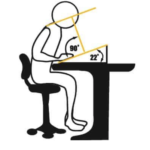How proper visual hygiene can help
While many Individuals feel that most vision disorders are either hereditary or naturally occurring, there is substantial evidence that many non-pathological (disease) vision disorders are related to how we use our eyes and the ergonomics (posture) we use in school and work. Commonly known conditions such as nearsightedness and astigmatism often develop from excessive near work and poor posture while reading or working at a desk. Other less known functional vision disorders including eye focusing (accommodation), eye teaming (fusion) and eye tracking (saccades) are also considered a breakdown in visual efficiency skills from prolonged visual stress and poor posture. While some visual conditions have obvious visual symptoms such as blurred or double vision, many symptoms of visual or binocular breakdown can also create behaviors that normally might not be associated with a vision problem.
Just because an individual has 20/20 eyesight and a current glasses prescription is no guarantee that all critical visual skills are intact and functioning efficiently.
Other behaviors and signs that visual dysfunction may exist include:
- Difficulty reading
- Headaches (tension or migraine)
- Symptoms resembling AD(H)D
- Chronic muscle tension in the neck or upper back
- Motion, or carsickness
- Behavior problems in academic study
- Avoidance of prolong near work activities (such as reading, games or hobbies)
Things you can do for your Visual Hygiene
Many of the previously mentioned vision disorders can have multiple causes in some may stem from other systemic problems. Much like the daily routine of dental hygiene, we can also practice visual hygiene to help reduce the incidence and severity of many visual conditions that affect our health and lifestyle goals. The following recommendations have been shown to be very helpful in developing good visual hygiene into reduction in many of the visual and behavioral adaptations mentioned above.
Figure provided by Visual Edge
Posture
Sit up straight to reduce muscle tension (stress) in the back, neck and shoulders. Do not read while lying on your back or stomach, or while resting the head on one hand with the elbow on the desk. Keep both eyes and equal distance from the desk or reading material, also your torso and hips parallel to the desk surface. The feet should be resting on the floor or on a support. The elbow should rest on the writing surface and the arm should remain parallel to the sides of the paper. The chair must provide proper support, allow for balanced posture and equal weight on both buttocks (no leaning to one side), and should be adjustable in seat height/back alignment.
Working Service
A sloped work surface that is tilted between 20 and 25 degrees from the horizontal reduces tension and stress on the head, neck, shoulders and eyes. Inexpensive slant boards are available for this purpose. More information on slant boards can be found by visiting Visual Edge’s website.
Working (Harmon) Distance
The optimal distance for visual efficiency varies from person to person. The distance is measured from the center of the middle knuckle to the elbow, and all reading and desk activity should be done at this distance or slightly further. Prolonged nearwork conducted closer than this distance is a major cause of visual that defects and functional vision breakdown.
Lighting
Balanced and adequate lighting on the desk material and in the room is crucial. Reduced lighting and glare in the room has an effect of decreasing peripheral vision sensitivity.
Penmanship and Pencil Grip
The pencil/pen should be held no closer than 3/4 inch from the tip. The fingers and knuckles should not become white/red when writing. Ergonomically correct pencil grips are available for students in early grades. Writing should involve mainly finger and wrist movement with a little in the room is crucial.
Stress Relieving Lenses
The lenses that are prescribed for distance use can often create stress when used for reading or desk work. Specific low powered reading lenses can be prescribed in single vision or bifocal form, depending on visual status or lifestyle needs. Individuals who use such lenses often report less headaches, neck or back tension, and increased reading efficiency. This need for such lenses can be determined by a development optometry specializing in vision therapy.
Visual Breaks
Practice “The 20/20/20 rule“. While studying and reading, periodically look up and away an object at least 20 feet away, at least every 20 minutes, for at least 20 seconds. It is also recommended to get up and walk around for at least five minutes every hour. Relaxation of body muscles has a carryover effect on visual relaxation.
TV Viewing
Do not sit closer than 6-7 feet from the TV screen. Adequate room light is crucial because watching TV in a dim or dark room reduces peripheral vision sensitivity. Excessive TV viewing reduces total body muscular development, which has a carryover effect on visual neuromuscular development. Video game use should be limited to no longer than 20 minutes sessions.
Reading While in Motion
Reading while in motion requires substantially more effort and creates additional visual stress then reading while stationary. Peripheral vision movement needs to be suppressed in addition to vision disturbance from the rest of the system in the ears. Reading while in motion should be limited.
Computer Use
In addition to the previous suggestions (such as posture, taking breaks, lighting and working distance), the position of the monitor is very crucial. The monitor should be placed as low as possible in relation to the head (eyes) position. When the monitor is too high, the eyes have a reduced ability to converge in the eyes tend open more causing more drying of the ocular tissues. In the case of bifocal wears, high monitors cause users to excessively raise their heads, causing more tension and stress in the neck and upper back.
Our Omaha Vision Therapy office specializes in testing, diagnosing and treating functional visual issues. If you have any questions about Vision Therapy and how it may impact your/or your child’s life, please call our office at 402.502.0043 or email us at [email protected].




